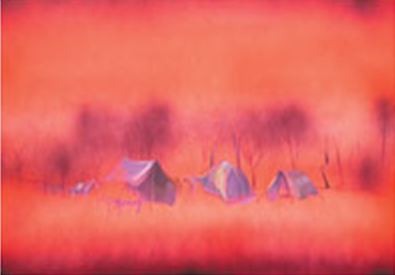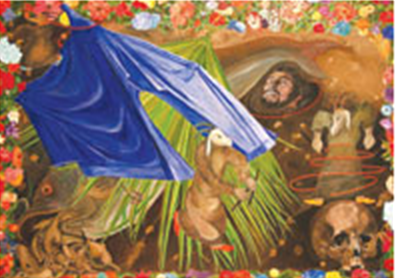Zarah David
This is a collection of articles archived for the excellence of their content. Readers will be able to edit existing articles and post new articles directly |
Zarah David
Emotional expression
Studying Zarah David’s work one finds an intriguing complexity of mood, partially disguised by the seeming simplicity of the imagery, writes Marjorie Husain
Though many of the freely painted areas of exhilarating colour in Zarah David’s work suggest landscape fantasies, a collection of her work also includes canvases in which a restrained palette creates highly dramatic visual experiences. The paintings are reflections of the artist’s own sensitivities rather than inspired by the colours of nature. She is currently showing an extensive body of work encompassing around 50 paintings collectively titled, ‘On the wings of a dream’, at Native Art Gallery, Lahore.
In this body of work one finds a gamut of emotional expression. Though born into a family of artists, and in earliest memories surrounded by art works, she has painted in isolation for most of her life.
Graduating as a gold medalist with a Masters in Fine Art from the University of Punjab in 1965, David chose music as her profession perhaps rebelling against the volatile nature of her parents Anna Molka Ahmed and Sheikh Ahmed. For David painting has been a private solace, an expression coming from a personal inner prospect that had for years, no thought of exhibition.
A change came about with the increasing interest shown in art and artists in recent years. Gallerists created networks of artists and collectors and fostered by appreciative recognition of her work, David was persuaded to hold her first solo exhibition in Karachi, 2006. The public response was instant, and from that time, the artist has shown her work in Islamabad, Lahore, and abroad, as well as returning to Karachi.
Studying the work currently on show at the Native Art Gallery, one finds an intriguing complexity of mood, partially disguised by the seeming simplicity of the imagery. Tracing angst and fears, as well as the brilliant outbursts of unsuppressed optimism in the work, the observer discovers revealing glimpses of a vulnerable artist.
Deeply influenced, it seems, by the era of violence we currently live in, there is a sequence influenced by forces bringing chaos to the lives of innocent people, painted in shades of mourning. One finds black and white vistas with the haunting suggestion of grieving forms appearing from shadows.
Darkly outlined male figures stepping into shades of grey march in line, perhaps workers returning home at the end of the day, or do they symbolise migration; the crossing of borders? Rendered with intuition, the work reflects human concerns shared universally. In this collection of work produced during the last two years, those that mourn are without defined gender.
Alternatively the artist can offer luminous, pristine landscapes with the mysterious reiteration of dreams evoking an awareness of the reference to fleeting periods of happiness. Alluding to the changing emotions in human relationships, the paintings are streaked with vibrant shades of orange, yellow and red. Areas of silver spray incorporated in some of the works add to the aura of unreality. The unique quality of David’s work is the secretive aspect which defies one’s attempt to create an easy narrative. One may study the work and find a reflection of a personal nature, changing from time to time and never quite sure.
On the cover: Strength
Left: Landscape in orange
Right: Landscape
Top right: Composition III



